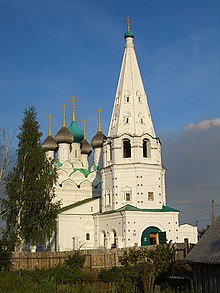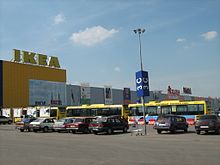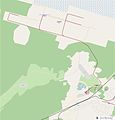|
Nizhny Novgorod Oblast
Nizhny Novgorod Oblast (Russian: Нижегородская область, romanized: Nizhegorodskaya oblast') is a federal subject of Russia (an oblast). Its administrative center is the city of Nizhny Novgorod. It has a population of 3,119,115 as of the 2021 Census. From 1932 to 1990 it was known as Gorky Oblast (Russian: Горьковская область). The oblast is crossed by the Volga River. Apart from Nizhny Novgorod's metropolitan area (including Dzerzhinsk, Bor and Kstovo) the biggest city is Arzamas. Near the town of Sarov there is the Serafimo-Diveyevsky Monastery, one of the largest convents in Russia, established by Saint Seraphim of Sarov. The Makaryev Monastery opposite of the town of Lyskovo used to be the location of the largest fair in Eastern Europe.[citation needed] Other historic towns include Gorodets and Balakhna, located on the Volga to the north from Nizhny Novgorod. Geography The oblast covers an area of 76,900 square kilometers (29,700 sq mi), which is approximately equal to the entire area of the Benelux countries or Czech Republic. Agricultural land occupies 41% of this area; forests, 48%, lakes and rivers, 2%; and other lands, 9%. Nizhny Novgorod Oblast borders Kostroma Oblast (N), Kirov Oblast (NE), the Mari El Republic (E), the Chuvash Republic (E), the Republic of Mordovia (S), Ryazan Oblast (SW), Vladimir Oblast (W), and Ivanovo Oblast (NW). Natural resourcesNizhny Novgorod Oblast is not rich in natural resources, which are limited to commercial deposits of sand (including titanium-zirconium sands), clay, gypsum, peat, mineral salt, and timber. HistoryThe sites of Pustyn I and the settlement of Naumovka I, Krasny Bor 5 and others belong to the Mesolithic era in the Nizhny Novgorod region. Burial grounds of the Fatyanovo culture of the Bronze Age were found in the Chkalovsky, Vetluzhsky and Krasnobakovsky districts.[14] In the course of the regional reform of Peter I in 1708, Nizhny Novgorod with the surrounding lands was added to the Kazan Governorate. In 1714, the Nizhny Novgorod Governorate was created. On January 14, 1929, the Nizhny Novgorod Oblast was formed.[15] On July 15 of the same year, it was transformed into the Nizhny Novgorod Territory. On October 7, 1932, the Nizhny Novgorod Territory was renamed the Gorky Territory (in honor of the writer Maxim Gorky). On December 5, 1936, the Gorky Territory was transformed into the Gorky Oblast (the Mari and Chuvash Republics were taken from the former territory).[16] On January 7, 1954, the Arzamas Oblast was separated from the Gorky Oblast. On April 23, 1957, the Arzamas Oblast was abolished, and its territory was returned to the Gorky Oblast. On October 22, 1990, by the Decree of the Presidium of the Supreme Soviet of the RSFSR, the Gorky Oblast was renamed the Nizhny Novgorod Oblast.[17][18] On April 21, 1992, the Congress of People's Deputies of Russia approved the decision of the presidium of the parliament to rename the region, amending Art. 71 of the Constitution of the RSFSR of 1978,[19] which entered into force on May 16, 1992.[20] Politics During the Soviet period, the high authority in the oblast was shared between three persons: the first secretary of the Nizhny Novgorod (then Gorki) CPSU Committee (who in reality had the greatest authority); the chairman of the oblast Soviet (legislative power); and the chairman of the oblast Executive Committee (executive power). After the abolition of Article 6 of the Constitution of the USSR in March 1990, the CPSU lost its monopoly on power. The head of the Oblast administration, and eventually the governor, was appointed/elected alongside the elected regional parliament. The Charter of Nizhny Novgorod Oblast is the fundamental law of the region. The Legislative Assembly of Nizhny Novgorod Oblast is the province's standing legislative (representative) body. The Legislative Assembly exercises its authority by passing laws, resolutions, and other legal acts and by supervising the implementation and observance of the laws and other legal acts passed by it. The highest executive body is the Oblast Government, which includes territorial executive bodies such as district administrations, committees, and commissions that facilitate development and run the day to day matters of the province. The Oblast administration supports the activities of the Governor who is the highest official and acts as guarantor of the observance of the oblast Charter in accordance with the Constitution of Russia. Sights The unique architectural construction—the 128-meter (420 ft) steel lattice hyperboloid tower built by the Russian engineer and scientist Vladimir Grigorievich Shukhov in 1929—is located near the town of Dzerzhinsk on the left bank of the Oka River. Administrative divisionsDemographics
Population: 3,119,115 (2021 Census);[21] 3,310,597 (2010 Census);[22] 3,524,028 (2002 Census);[23] 3,714,322 (1989 Soviet census).[24] According to the 2010 Census,[22] ethnic Russians at 3,109,661 made up 95.1% of the oblast's population. Other ethnic groups included Tatars (44,103, or 1.4%), Mordva (19,138, or 0.6%), Ukrainians (17,657, or 0.5%), and various smaller groups, each accounting for less than 0.5% of the total. Additionally, 42,349 people were registered from administrative databases, and could not declare an ethnicity. It is estimated that the proportion of ethnicities in this group is the same as that of the declared group.[25] Vital statistics for 2022:[26][27]
Total fertility rate (2022):[28] Life expectancy (2021):[29] According to the Federal Migration Service, 20,450 foreign citizens were registered in the oblast in 2006. The actual number of foreigners residing in the oblast as of June 1, 2006 was estimated to be over 22,000.[30]
According to a 2012 survey[33] 69.2% of the population of Nizhny Novgorod Oblast adheres to the Russian Orthodox Church, 2% are unaffiliated generic Christians, 2% are Orthodox Christian believers without belonging to any church or members of other Orthodox churches, and 1% are adherents of the Slavic native faith (Rodnovery). In addition, 15% of the population declares to be "spiritual but not religious", 10% is atheist, and 0.8% follows other religions or did not give an answer to the question.[33] Economy  The oblast ranks seventh in Russia in industrial output. Processing industries predominate in the local economy. More than 650 industrial companies employ nearly 700,000 people, or 62% of the workforce involved in material production. Industry generates 83% of the regional GDP and accounts for 89% of all material expenditures. The leading sectors are engineering and metalworking, followed by chemical and petrochemical industries and forestry, woodworking, and paper industries. The first three sectors account for about 75% of all industrial production. The oblast has traditionally been attractive to investors. In 2002, Moody's rating agency confirmed a Caa1rating based on the region's long-term foreign currency liabilities.[34]  The region maintains trade relations with many countries and has an export surplus. The largest volume of exports goes to Ukraine, Belarus, Switzerland, Kazakhstan, Belgium, and France. Imports come mainly from Ukraine, Germany, Belarus, Kazakhstan, Austria, Netherlands, China, and the United States. The stock market infrastructure is quite well developed in Nizhny Novgorod, and the exchange business is expanding. Companies and organizations registered in the region include 1153 joint-stock companies, 63 investment institutions, 34 commercial banks, 35 insurance companies, 1 voucher investment fund, 1 investment fund, 17 nongovernmental pension funds, 2 associations of professional stock market dealers, and 3 exchanges (stock, currency, and agricultural). The oblast is noted for having relatively highly developed market relations. Today, the region needs serious partners interested in equitable, long-term, mutually beneficial partnerships. There are 650+ industrial companies in the region,[35] most of them engaged in the following sectors:
These key industries are supplemented by other sectors of the economy such as agriculture, trade, services, communications and transport. Transportation
Narrow gauge railways in the region: ReferencesNotes
Sources
External linksWikimedia Commons has media related to Nizhny Novgorod Oblast. Wikivoyage has a travel guide for Nizhny Novgorod Oblast.
|
||||||||||||||||||||||||||||||||||||||||||||||||||||||||||||||||||||||||||||||||||||||||||||||






